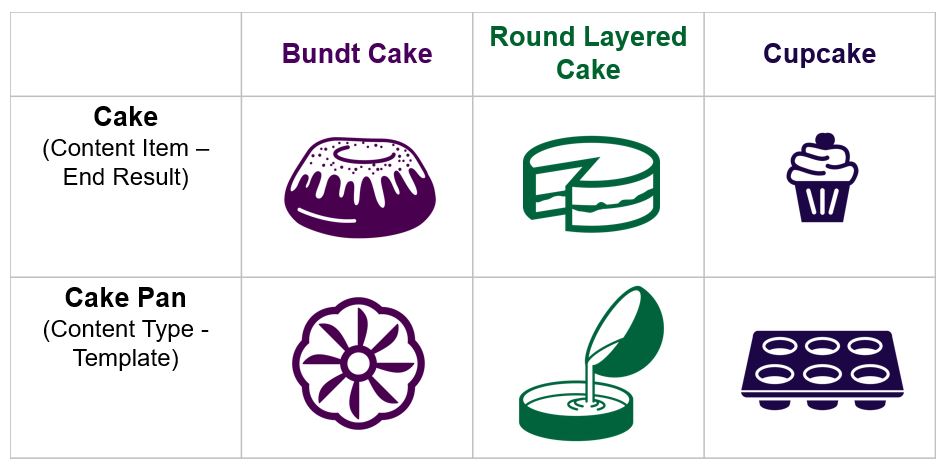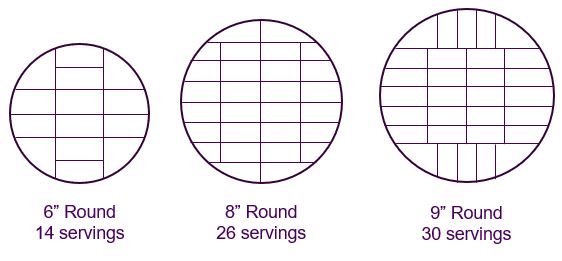More often than ever, our clients’ Intranet projects involve developing and implementing Content Types to improve the creation and management of content. This includes the creation of news articles, policies, guidelines, and other common Intranet content items. The overwhelming amount of corporate information, plus the variety of types of content, make it essential to bring order to chaos. However, it is often a challenge to explain to content creators, content editors, and end users the meaning of a content type.
Content Types and Cake Pans
Imagine that you are a baker who produces three different types of cakes: bundt cakes, round layered cakes, and cupcakes. How can you ensure that the shape and quality of the cakes you produce is standard and optimal for each type of cake? In other words, how can you make sure that all the bundt cakes are the same shape and size regardless of their flavor?

To bake a bundt cake, you need to use a fluted tube pan; to bake a round layered cake, you need a springform cake pan; and to bake a cupcake, you need a cupcake pan. All of these baking pans act as “templates,” ensuring that you have control over the shape and quality of the cake you want to bake. Thus, the next time you want to bake either a bundt cake, a round layer cake, or a cupcake, you can reuse the same pans and expect to obtain similar, if not the same results.
Similarly to cake pans, Content Types work as reusable templates ensuring that when you create a piece of content for your company’s Intranet, for example a news article, it is standard and consistent with any other news articles already published on the Intranet.
Definition of a Content Type
In technical terms, a Content Type is a reusable collection of metadata for a category of content, with its corresponding taxonomies that allows you to manage information in a centralized, reusable way. Ideally, Content Types should also include the following:
- Data Entry Wireframe – a low-fidelity wireframe illustrating how content creators or content editors will create or edit a content item for the Intranet;
- Front-End Wireframe – a wireframe that shows how content will be presented to end users of the Intranet;
- Style Guidelines – instructions about content length and format to guarantee that every new content item is created consistently according to standards and best practices; and
- Workflow – process steps that help ensure that each content type is always handled the same way (e.g., approval workflow).
To continue with our cakes analogy, a cake pan helps the baker and assistants ensure that the cakes are produced in a standard way. Let’s assume that you are making a round layered cake and identify the metadata and other key content type components.
- Content Type: Round Layered Cake pan
- Sample metadata and corresponding taxonomy values for the round layered cake are listed below:
- Cake Type: Birthday Cake
- Cake Diameter: 8″
- Cake Height: 4″
- Number of Servings: 26
- Flavor: Vanilla
- Ingredients: (list of ingredients)
- The equivalent of a data entry wireframe would be a simple drawing illustrating how the cake pan looks:

- The equivalent of a front-end wireframe would be a picture of the fully baked cake to be used as a reference for presentation purposes.

- The equivalent of the style guidelines would be the instructions for adding the frosting and achieving the final presentation, such as:
- Place one cake layer right-side up on a cake plate or stand, and spread with 1 cup of the frosting.
- Top with the second cake layer.
- Frost the top and sides of the cake with the remaining frosting.
- Etc.
- The equivalent of the workflow would be the directions to bake the cake, such as:
- Preheat the oven to 350 degrees Fahrenheit.
- Beat the butter, sugar, and oil in a large bowl with an electric mixer on medium-high speed until light in color and fluffy, about 5 minutes.
- Beat in the eggs, one at a time, and then the vanilla until combined.
- Etc.
- The end result will be a Round Layered Cake!
Even though content creation for an Intranet should be as appealing as baking a cake, it is not often the case. Well defined content types play a key role in making it easier for content creators and content editors to populate the Intranet with the right content and in the right format. As a result, your company’s Intranet will benefit from improved content access, visibility, presentation, and maintenance.
The definition of content types and metadata is one facet of developing a content model which in turn operationalizes the content strategy and content operations of your organization. Need help ensuring your content is realizing business value for your organization? Contact us!
